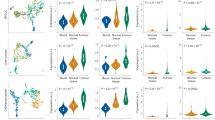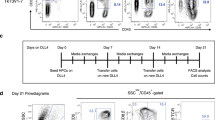Abstract
Recombinant human fibronectin fragment (FN-CH296, RetroNectin) has been widely used for retroviral gene therapy to enhance gene transfer efficiency. Based on the observation that immobilized FN-CH296 together with anti-CD3 monoclonal antibodies (anti-CD3) enhanced cell proliferation while conserving the naive phenotype of T cells, we used FN-CH296 costimulation to generate engineered T cells. For comparison, human peripheral blood mononuclear cells were stimulated under three kinds of conditions including anti-CD3 only, anti-CD3 and anti-CD28 monoclonal antibodies conjugated with beads (anti-CD3/anti-CD28) and immobilized FN-CH296 together with anti-CD3 (anti-CD3/FN-CH296); all three treatments were followed by retroviral gene transfer. Of all the stimulation methods, the one involving anti-CD3/FN-CH296 produced the most cell expansion with conservation of the naive phenotype. Engineered T cells were transplanted into NOD/SCID (non-obese diabetic/severe combined immunodeficient) mice, and all the mice were killed 14 days later. Transplanted T cells were detected in all the mice; however, mice injected with anti-CD3/FN-CH296-stimulated T cells showed higher transgene expression in organs than mice injected with anti-CD3-stimulated cells. These results demonstrate that the anti-CD3/FN-CH296 stimulation can be an efficient way to generate large numbers of genetically modified T cells that can provide higher and longer lasting levels of transgene expression in vivo and that are suitable for adoptive T-cell transfer therapy.
This is a preview of subscription content, access via your institution
Access options
Subscribe to this journal
Receive 12 print issues and online access
$259.00 per year
only $21.58 per issue
Buy this article
- Purchase on Springer Link
- Instant access to full article PDF
Prices may be subject to local taxes which are calculated during checkout



Similar content being viewed by others
References
June CH . Principles of adoptive T cell cancer therapy. J Clin Invest 2007; 117: 1204–1212.
Yee C, Thompson JA, Byrd D, Riddell SR, Roche P, Celis E et al. Adoptive T cell therapy using antigen-specific CD8+ T cell clones for the treatment of patients with metastatic melanoma: in vivo persistence, migration, and antitumor effect of transferred T cells. Proc Natl Acad Sci USA 2002; 99: 16168–16173.
Dudley ME, Wunderlich JR, Robbins PF, Yang JC, Hwu P, Schwartzentruber DJ et al. Cancer regression and autoimmunity in patients after clonal repopulation with antitumor lymphocytes. Science 2002; 298: 850–854.
Hombach A, Heuser C, Abken H . The recombinant T cell receptor strategy: insights into structure and function of recombinant immunoreceptors on the way towards an optimal receptor design for cellular immunotherapy. Curr Gene Ther 2002; 2: 211–226.
Schumacher TN . T-cell-receptor gene therapy. Nat Rev Immunol 2002; 2: 512–519.
Morgan RA, Dudley ME, Wunderlich JR, Hughes MS, Yang JC, Sherry RM et al. Cancer regression in patients after transfer of genetically engineered lymphocytes. Science 2006; 314: 126–129.
Gattinoni L, Powell Jr DJ, Rosenberg SA, Restifo NP . Adoptive immunotherapy for cancer: building on success. Nat Rev Immunol 2006; 6: 383–393.
Gattinoni L, Klebanoff CA, Palmer DC, Wrzesinski C, Kerstann K, Yu Z et al. Acquisition of full effector function in vitro paradoxically impairs the in vivo antitumor efficacy of adoptively transferred CD8+ T cells. J Clin Invest 2005; 115: 1616–1626.
Robbins PF, Dudley ME, Wunderlich J, El-Gamil M, Li YF, Zhou J et al. Cutting edge: persistence of transferred lymphocyte clonotypes correlates with cancer regression in patients receiving cell transfer therapy. J Immunol 2004; 173: 7125–7130.
Huang J, Khong HT, Dudley ME, El-Gamil M, Li YF, Rosenberg SA et al. Survival, persistence, and progressive differentiation of adoptively transferred tumor-reactive T cells associated with tumor regression. J Immunother 2005; 28: 258–267.
Zhou J, Shen X, Huang J, Hodes RJ, Rosenberg SA, Robbins PF . Telomere length of transferred lymphocytes correlates with in vivo persistence and tumor regression in melanoma patients receiving cell transfer therapy. J Immunol 2005; 175: 7046–7052.
Yoder MC, Williams DA . Matrix molecule interactions with hematopoietic stem cells. Exp Hematol 1995; 23: 961–967.
Ruoslahti E . Fibronectin and its receptors. Annu Rev Biochem 1988; 57: 375–413.
Hynes RO . Integrins: versatility, modulation, and signaling in cell adhesion. Cell 1992; 69: 11–25.
Nojima Y, Humphries MJ, Mould AP, Komoriya A, Yamada KM, Schlossman SF et al. VLA-4 mediates CD3-dependent CD4+ T cell activation via the CS1 alternatively spliced domain of fibronectin. J Exp Med 1990; 172: 1185–1192.
Nojima Y, Rothstein DM, Sugita K, Schlossman SF, Morimoto C . Ligation of VLA-4 on T cells stimulates tyrosine phosphorylation of a 105-kD protein. J Exp Med 1992; 175: 1045–1053.
Sato T, Tachibana K, Nojima Y, D’Avirro N, Morimoto C . Role of the VLA-4 molecule in T cell costimulation. Identification of the tyrosine phosphorylation pattern induced by the ligation of VLA-4. J Immunol 1995; 155: 2938–2947.
Kimizuka F, Taguchi Y, Ohdate Y, Kawase Y, Shimojo T, Hashino K et al. Production and characterization of functional domains of human fibronectin expressed in Escherichia coli. J Biochem (Tokyo) 1991; 110: 284–291.
Muraki N, Ideno M, Nukaya I, Sagawa H, Enoki T, Kato I . T cell expansion using RetroNectin (I): useful method to expand T cells, characterized by high portion of naive T-like cells. Sixty-Fifth Annual Meeting of the Japanese Cancer Association; 29 September 2006; Yokohama, Kanagawa. Japanese Cancer Association: Shinjuku, Tokyo, 2006.
Ideno M, Muraki N, Nukaya I, Sagawa H, Enoki T, Kato I . T cell expansion using RetroNectin (II): RN-T cells contain high portion of naïve T-like cells and show high ability of antigen recognition. Sixty-Fifth Annual Meeting of the Japanese Cancer Association; 29 September 2006; Yokohama, Kanagawa. Japanese Cancer Association: Shinjuku, Tokyo, 2006.
Yu SS, Kim JM, Kim S . High efficiency retroviral vectors that contain no viral coding sequences. Gene Therapy 2000; 7: 797–804.
Hong Y, Yu SS, Kim JM, Lee K, Na YS, Whitley CB et al. Construction of a high efficiency retroviral vector for gene therapy of Hunter's syndrome. J Gene Med 2003; 5: 18–29.
Wherry EJ, Teichgräber V, Becker TC, Masopust D, Kaech SM, Antia R et al. Lineage relationship and protective immunity of memory CD8 T cell subsets. Nat Immunol 2003; 4: 225–234.
Klebanoff CA, Gattinoni L, Torabi-Parizi P, Kerstann K, Cardones AR, Finkelstein SE et al. Central memory self/tumor-reactive CD8+ T cells confer superior antitumor immunity compared with effector memory T cells. Proc Natl Acad Sci USA 2005; 102: 9571–9576.
Dardalhon V, Jaleco S, Rebouissou C, Ferrand C, Skander N, Swainson L et al. Highly efficient gene transfer in naive human T cells with a murine leukemia virus-based vector. Blood 2000; 96: 885–893.
Sallusto F, Lenig D, Förster R, Lipp M, Lanzavecchia A . Two subsets of memory T lymphocytes with distinct homing potentials and effector functions. Nature 1999; 401: 708–712.
Levine BL, Bernstein WB, Connors M, Craighead N, Lindsten T, Thompson CB et al. Effects of CD28 costimulation on long-term proliferation of CD4+ T cells in the absence of exogenous feeder cells. J Immunol 1997; 159: 5921–5930.
Acknowledgements
We thank Kiyozou Asada for critical reading and helpful comments.
Author information
Authors and Affiliations
Corresponding author
Additional information
Supplementary Information accompanies the paper on Cancer Gene Therapy website (http://www.nature.com/cgt)
Supplementary information
Rights and permissions
About this article
Cite this article
Yu, S., Nukaya, I., Enoki, T. et al. In vivo persistence of genetically modified T cells generated ex vivo using the fibronectin CH296 stimulation method. Cancer Gene Ther 15, 508–516 (2008). https://doi.org/10.1038/cgt.2008.21
Received:
Revised:
Accepted:
Published:
Issue Date:
DOI: https://doi.org/10.1038/cgt.2008.21
Keywords
This article is cited by
-
Effects of polybrene and retronectin as transduction enhancers on the development and phenotypic characteristics of VHH-based CD19-redirected CAR T cells: a comparative investigation
Clinical and Experimental Medicine (2022)
-
A clinically applicable and scalable method to regenerate T-cells from iPSCs for off-the-shelf T-cell immunotherapy
Nature Communications (2021)
-
Comparison of IL-2 vs IL-7/IL-15 for the generation of NY-ESO-1-specific T cells
Cancer Immunology, Immunotherapy (2019)



